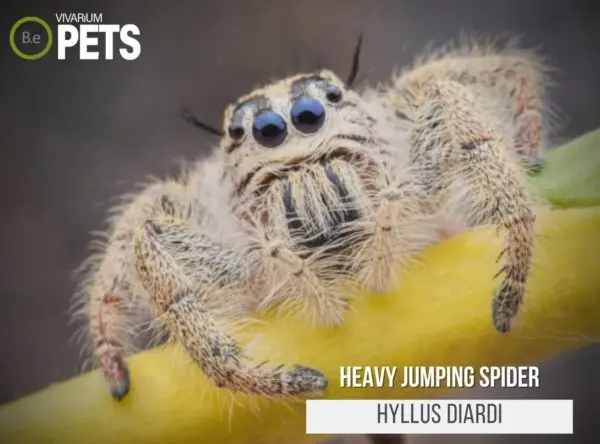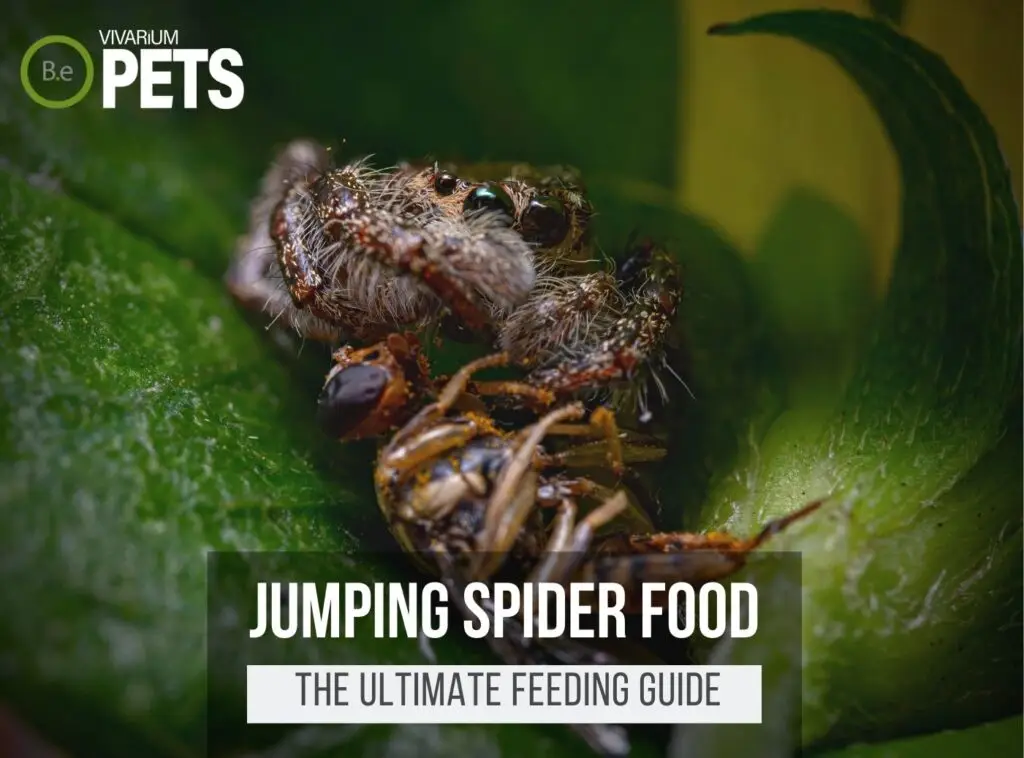Are you looking for an exciting new addition to your pet collection?
The Heavy Jumping Spider, or Hyllus diardi, is an intriguing mini predator worth considering!
This impressively “large-for-a-jumping-spider” species naturally inhabits the regions of Africa and they are becoming increasingly popular as jumping spider pets.
With unique features and a fairly simple setup, the Heavy Jumper is sure to be the star of your next habitat.
Here, you’ll find an easy-to-read guide to keeping Hyllus diardi thriving and actively on the prowl.
Let’s get started!
| Characteristics: | |
|---|---|
| Common Name | Heavy Jumping Spider |
| Family Name | Salticidae |
| Scientific Name | Hyllus diardi |
| Use | Pets |
| Temperament | Non-aggressive |
| Lifespan | 1 to 3 Years |
| Diet | Insectivore |
| Adult Size | up to 1.5 cm |
| Breeding Type | Egg Layer |
| Care Level | Moderate |
| Minimum Tank Size | 5-10 Gallons |
| pH | 6.8-7.2 |
| Hardness | Moderate |
| Temperature | 68-88°F |
Table Of Contents:
ToggleWhat Are Heavy Jumping Spiders?
The Heavy Jumping spider, scientifically known as Hyllus diardi, is a member of the family Salticidae and is a common species of jumping spider.
With bold body markings, colorful abdomens, and eyes extremely large for their head, these spiders are one of the most impressive to own.
The common name of the Heavy Jumping spider comes from the fact that they are much larger than most other members of the Salticidae family.
They naturally inhabit regions in Africa and can now also be found as pets around the world.
Create the perfect home for your arachnid with our Customizable Spider Enclosure Kits, designed to meet all their habitat needs.
What Do Heavy Jumping Spiders Look Like?
Hyllus diardi are relatively large spiders, growing up to 15mm long.
They have a distinct look, with a mix of orange, yellow, and black banding on the legs and abdomen, and a lightly-colored cephalothorax with two white stripes that run lengthwise.
Its limbs are well-adapted for jumping, with very strong back legs.
Its eyes are unusual, being arranged in a circle pattern with two pairs situated in the front of its head, and a large pair set further back.
Benefits Of Using Heavy Jumping Spiders
By using Hyllus diardi in your vivarium, you can expect several benefits.
Not only is the Heavy Jumping spider an exciting species with a unique look, but it is also fairly easy to care for in comparison to other exotic spiders.
It also offers a fun challenge to its keeper as it is known to be an intelligent and active species that requires ample stimulation.
H. diardi also helps create a balanced ecosystem in the enclosure by providing pest control and preventing issues such as mite infestations.
Furthermore, it is also a great source of nutrient-rich protein for other species living in your enclosure.

Hyllus diardi Facts
Hyllus diardi are active hunters that have an average lifespan of a few years.
This species of spider is also known for its impressive defensive capabilities.
H. diardi can raise their forelimbs and display a large pair of yellow-tinted fangs that open and close to ward off predators.
They can also run away quickly or enter a defensive posture to deter any perceived threats.
They are fairly docile and their natural diet consists of small insects, arachnids, and spiders.
Breeding these spiders can be tricky due to their difficulty in distinguishing between males and females, but with patience and attention, it can be done successfully.
Habitat
Hyllus diardi is a medium to large-sized jumping spider found in the tropical rainforests of Africa and Madagascar.
This species prefers habitats with well-developed forests, especially wet forests in lowlands and mountains.
They may live in trees, under stones, and in leaf litter among other places.
These spiders have well-developed eyes that are adapted for hunting and detecting movement from relatively far away.
Replicate their natural habitat perfectly with our bioactive species-specific soil mixes, designed to provide the ideal moisture and organic content for your arachnids.
Diet
The Heavy Jumping Spider is an opportunistic hunter in the wild, meaning they will eat whatever is available and meet their nutritional needs.
In nature, they are known to dine on insects, worms, and arachnids such as other spiders.
Temperament
When it comes to temperament, Heavy Jumping spiders are typically quite laid-back and calm when around humans.
Because they’re used to warmer climates, they often move slowly and cautiously due to the climate difference.
They don’t generally like to be handled, so it’s important to just observe and enjoy the information that you can gain from them without trying to physically interact.
They are also non-aggressive to other animals, which can make owning multiple species within the same enclosure possible.
Since they lack venom strong enough to affect humans, they are considered to be a safe pet to have around small children.
Lifespan
The average lifespan of Hyllus diardi is anywhere between 1-3 years in captivity.
This species typically takes a full year to mature, with females living longer than males.
During this time, the species matures through some phases: egg, spiderling, subadult, and adult.
After hatching, the young spider takes between six and seven weeks to reach the adult stage.
As it grows, the spider will require more food and therefore it is recommended to feed the spider according to its size.
Sometimes, the spider may stop eating for several days, usually during a molting process – but this behavior is natural and should not be of concern.
Breeding
The mating and reproduction process of Hyllus diardi spiders is fascinating and complicated.
While males typically live for a little over a year, the lifespan of female H. diardi is considerably longer at around two to three years.
To initiate the process, the male will perform a courtship ritual to attract the female.
If successful, the mating ritual can last anywhere from half an hour to several hours.
When a female spider is ready to reproduce she will make a unique web-like cocoon to store her eggs.
Once she lays her eggs and the web is complete, it will be kept in a secure area, and can take several weeks for the eggs to hatch.
When hatching, the baby spiders will immediately search for shelter to hide away from potential predators.
Where To Find Heavy Jumping Spiders
When it comes to finding Hyllus diardi, there are a variety of possibilities.
If you’re looking for a wild Heavy Jumper, you’ll have the best luck in dense, humid jungle areas and secondary forest regions.
Alternatively, you can shop for Heavy Jumping spiders with a variety of online vendors.
Unfortunately, before purchasing, be sure that you’re buying from a reputable source, as there are plenty of unethically-sourced spiders in the pet trade.
Do your research and check the vendor’s reviews if you’re uncertain.
Additionally, you may find jumping spiders at your local pet store.
Remember to thoroughly inspect their enclosure and pay attention to their health and behavior.
Hyllus diardi Care
To care for the Heavy Jumping spider you’ll need to provide adequate housing, the proper terrarium soil, and a suitable diet.
Additionally, ensure their habitat is kept clean, spot treat for mites, and handle them with care.
When breeding, prepare an ideal mating environment with the recommended temperature and humidity levels.
With the proper set-up and care, your Heavy Jumping spider will stay active and always at its peak.
Tank Requirements
The ideal tank setup for Hyllus diardi is a bioactive setup that provides plenty of space for them to climb.
A glass terrarium measuring at least 10 gallons is recommended.
The enclosure should be equipped with netting to provide protection, hiding spots, and branches for climbing.
The ideal pH level for the water supplied should range between 6.8 and 7.2, and the hardness should be kept at 1-3 GH.
Additionally, the temperature should be kept around 80°F and no higher than 88°F.
Cypress mulch, peat moss, vermiculite, or coco fiber can work well as a substrate. As for terrarium lighting, the tank should have a humid environment with natural sunlight.
If natural sunlight does not provide enough, an artificial bulb can further increase the health and lifespan of your spider.
What Do Heavy Jumping Spiders Eat?
Feeding your Hyllus semicupreus should be done with careful precision – they are naturally smaller and require more attention when selecting the right food sources.
Generally, they prefer to eat live prey such as crickets, grasshoppers, small cockroaches, moths, and flies.
They can also be fed a variety of worms such as waxworms, silkworms, and mealworms.
It is also important to remember to offer a variety of food to increase the variety of nutrients they get.
Lastly, Heavy Jumping spiders should have access to fresh and clean water.
Tap water is acceptable, but if you’d like to give them the best, use filtered water to care for your Heavy Jumper.
If you’re looking for a more detailed approach to feeding these critters, be sure to check out my ultimate DIY jumping spider food guide. I give a more in-depth explanation of the best foods and my favorite recipe.
Best Tankmates For Heavy Jumping Spiders
When it comes to tankmates for Hyllus diardi, it is not advised to keep them with other spiders as they may become predatory.
It is also important to avoid any other species that would compete for food or space in the terrarium.
Some ideal tankmates for Heavy Jumping Spiders would be small, docile inverts such as dwarf pill millipedes, roaches, or isopods such as woodlice.
All of these animals thrive in a similar habitat, with food and calcium sources, and are not aggressive to their tankmates.
No matter what makes up the tank, it is vital to create a safe, secure, and healthy environment so that all of the inhabitants can live in harmony.
With this in mind, any possible tankmates of H. diardi should be well-researched and carefully considered before moving them into the terrarium.
Conclusion
By following this care guide, your Heavy Jumping spider can live an enjoyable life.
Providing the right set-up, securing the appropriate food sources, and monitoring the cleanliness of the habitat are all essential to successful Hyllus semicupreus ownership.
With the knowledge and tips provided in this guide, your Heavy Jumper should be a happy pet for many years to come!
Create the ideal habitat for your arachnids with our species-specific soil mixes and Spider Enclosure Kits. These products provide everything you need for a thriving spider habitat.
Frequently Asked Questions
No, Hyllus Diardi is not poisonous.
Males of the Hyllus Diardi species typically reach a body length of up to 1.5 cm.
Hyllus diardi, a non-aggressive jumping spider, is capable of biting if threatened but their bites are generally considered harmless to humans, causing only mild local irritation similar to a mosquito bite.





